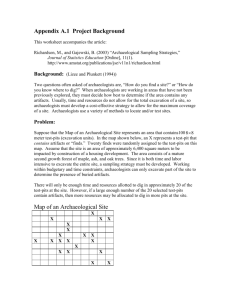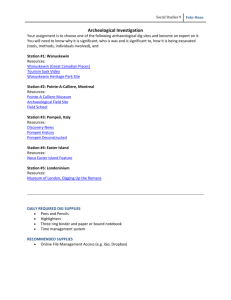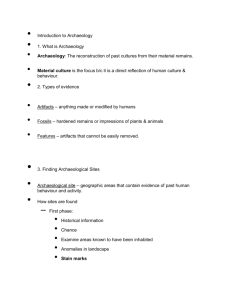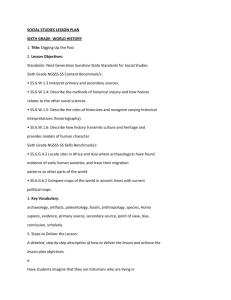JBH exhibit proposal
advertisement
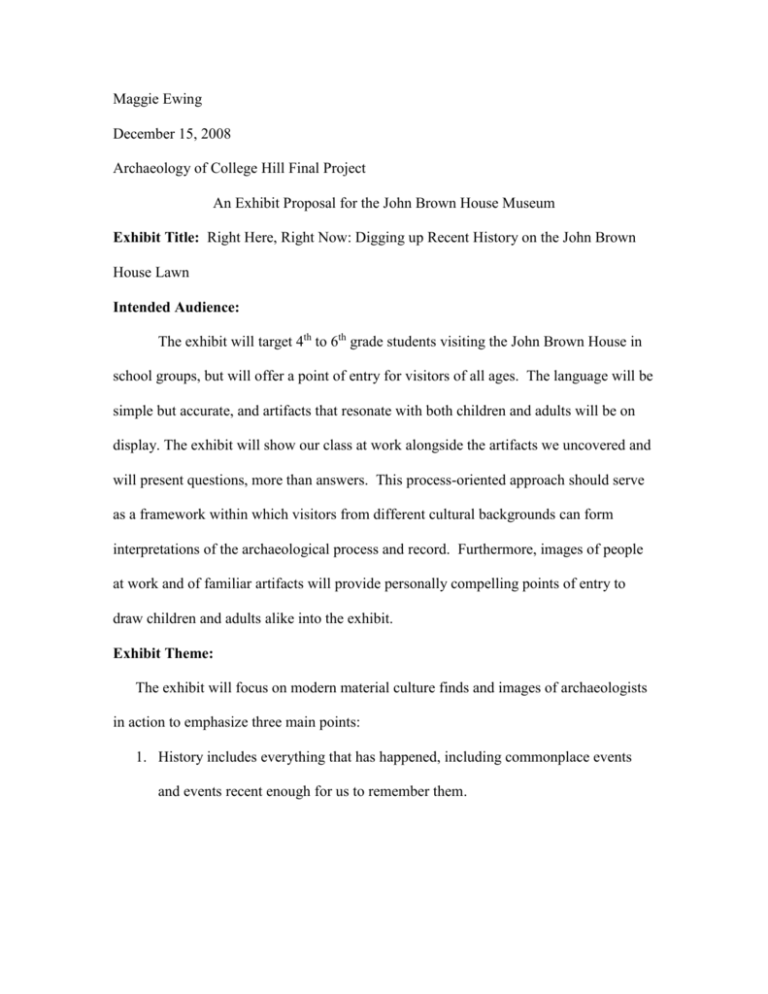
Maggie Ewing December 15, 2008 Archaeology of College Hill Final Project An Exhibit Proposal for the John Brown House Museum Exhibit Title: Right Here, Right Now: Digging up Recent History on the John Brown House Lawn Intended Audience: The exhibit will target 4th to 6th grade students visiting the John Brown House in school groups, but will offer a point of entry for visitors of all ages. The language will be simple but accurate, and artifacts that resonate with both children and adults will be on display. The exhibit will show our class at work alongside the artifacts we uncovered and will present questions, more than answers. This process-oriented approach should serve as a framework within which visitors from different cultural backgrounds can form interpretations of the archaeological process and record. Furthermore, images of people at work and of familiar artifacts will provide personally compelling points of entry to draw children and adults alike into the exhibit. Exhibit Theme: The exhibit will focus on modern material culture finds and images of archaeologists in action to emphasize three main points: 1. History includes everything that has happened, including commonplace events and events recent enough for us to remember them. 2. Archaeology draws connections between material culture and the cultures that made and used them. These connections can apply to our own culture and material culture. 3. Archaeology incorporates a variety of methods, including excavation, documentary research, and laboratory analysis, to create knowledge about the past. These points reflect the interests of some Providence elementary school teachers as communicated to me by Kirsten Hamerstrom as well as our class’s desire for an exhibition that would leave room for multiple informed interpretations. By focusing on modern material culture, the exhibit will present visitors with the archaeological imprint left by their own culture. As they see the connection between a culture they know intimately and its archaeological remains, they will gain a sense of the kinds of inferences archaeologists make about other cultures. Archaeologists’ tools, images of finds and related documentary evidence, and images of archaeologists at work with further this understanding of what archaeology is and what kinds of information it can access. The focus on modern artifacts and the archaeological process has the added benefit of being adaptable to new finds. One of the panels could easily be replaced by a future Archaeology of College Hill class to reflect historically interesting finds, and more artifacts could be added to the case. Whatever significance these future finds have will be supported by the general information about archaeology and archaeological knowledge that my exhibit provides. Description of the Exhibit: The exhibit will be housed in a 28”x26”x16” case in the Washington Wallpaper Room at the John Brown House. The case will be lined with plain cotton canvas that the John Brown House has on hand. On the back of the case will hang three panels. Panel 1, 7.5” x 19”: Images: photograph of Archaeology of College Hill class excavating, photograph of drying screen will objects arranged by material type Text (Helvetica 55 pt.): “Archaeologists look at material culture—all the stuff people make and use—to learn about how people lived in the past. What does this stuff tell you about Rhode Islanders?” Panel 2, 17” x 8”: Heading (Helvetica 90 pt.): “Coffee culture” Image: Photograph of McDonalds coffee lid Text (Helvetica 18 pt.) “Rhode Islanders love their coffee! All of these Coffee artifacts were excavated from the John Brown House lawn.” Image: Photograph of coffee milk container Text: “Do you drink coffee milk from a carton? Look what’s left of it after 20 years underground” Images: Photographs of Mr. Donut and Dunkin Donuts cup fragments Text: Mr. Donut was a brand that sold coffee and donuts in Rhode Island until Dunkin Donuts bought the company and changed the stores’ names. Both donut shops left their marks on the archaeological record. What kinds of coffee does your family drink? Image: Photograph of McDonalds coffee cup lid Text: Where do you see lids like this one? Panel 3, 17” x 8”: Heading (Helvetica 90 pt.): “When are we?” Images: Photograph of John Brown House fence, photograph of fence post fragment. Text (Helvetica 18 pt.): Archaeologists uncovered this piece of the John Brown House’s fence. When did it first fall on the ground? Image: photograph of RIHS newsletter article about 1974 fence repair. Text: An old newsletter says the fence was repaired in 1974. Did a piece of the fence get buried then? Image: Close-up photograph of “REAL” logo from coffee milk container Text: The “REAL” logo on this coffee milk container didn’t exist until 1976. If the fence post and the milk carton were found near each other, do they come from the same time? On the base of the case, artifacts from Archaeology of College Hill excavations will be displayed. In the far left corner, a trowel, a tape measure, and a pencil will add visual appeal and emphasize the connection between the archaeological process and the artifacts it uncovered. Catalogue descriptions for all artifacts will be included on a card in the near right corner of the case. Catalogue descriptions: 1. McDonalds cup lid Plastic c. 1970-1990 2. John Brown House fence fragment Wood c. 1970-1990 3. Coffee milk carton Plastic Post-1976 4. Dunkin Donuts cup fragment Styrofoam Post-1959 5. Mr. Donut cup fragment Styrofoam 1959-1990 6. Archaeologist’s trowel Used to dig through soil Modern 7. Archaeologist’s tape measure Used to measure depth and placement of artifacts and soil Modern 8. Archaeologist’s pencil Used to record archaeological finds and process Modern Sample interpretive speech for adult tour: Everyone who owned this house left behind information about themselves in the objects they used—we’ve seen some of their dishes and clothes, some of the things they used for decoration and entertainment. But people have been making history at the John Brown House even since it became a museum, and we’ll keep doing it after you leave here today. Some students at Brown University started an archaeological excavation on the lawn here last fall. They found artifacts from the seventeenth, eighteenth, and nineteenth centuries, but what they gave us to display were their modern finds. They said that digging through remains left behind by our own modern American culture gave them an idea of the ways we’re making history every day. It makes me wonder how we’ll be remembered in a few hundred years. Sample interpretive speech for school group tour: “The Browns and the other families who lived in the house left behind a lot of the things you’ve seen here, like the clothes they wore and the games they played and the dishes they ate off of. Looking at all that physical stuff is one way you can learn about history. Who knows what archaeology is? (someone responds). Yeah, archaeology is looking for artifacts—that’s stuff made by people—and using them to figure out what people’s lives were like. It’s a way of finding out about history.” “So what does this artifact have to do with history?” Pass around a modern empty coffee milk container. Encourage students to talk about what it is, when they’ve used something like it. “Well coffee milk is part of our history! Everything we do today is part of history by tomorrow! Archaeologists in the future could see an artifact like this one and know that some kids in Rhode Island liked to drink coffee milk. Look at some of the stuff these archaeologists found outside on our lawn.” Point out pictures of people digging, examples of tools, coffee milk container remnant.


